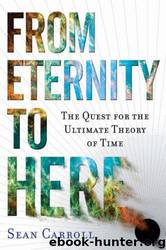From Eternity to Here: The Quest for the Ultimate Theory of Time by Sean M. Carroll

Author:Sean M. Carroll [Carroll, Sean M.]
Language: eng
Format: epub, mobi
Tags: Science, Energy, Space and time, Cosmology, Mathematical Physics, Time, Quantum theory, Physics
ISBN: 9780525951339
Publisher: Dutton
Published: 2010-04-14T21:00:00+00:00
COLLAPSE OF THE WAVE FUNCTION
The thing about this discussion that tends to rub people the wrong way—and with good reason—is the crucial role played by observation. When we observed what the cat was doing at the scratching-post/food-bowl juncture, we got one answer for the final state; when we didn’t make any such observation, we got a very different answer. That’s not how physics is supposed to work; the world is supposed to evolve according to the laws of Nature, whether we are observing it or not. What counts as an “observation,” anyway? What if we set up surveillance cameras along the way but then never looked at the tapes? Would that count as an observation? (Yes, it would.) And what precisely happened when we did make our observation?
This is an important collection of questions, and the answers are not completely clear. There is no consensus within the physics community about what really constitutes an observation (or “measurement”) in quantum mechanics, nor about what happens when an observation occurs. This is the “measurement problem” and is the primary focus of people who spend their time thinking about interpretations of quantum mechanics. There are many such interpretations on the market, and we’re going to discuss two: the more or less standard picture, known as the “Copenhagen interpretation,” and a view that seems (to me) to be a bit more respectable and likely to conform to reality, which goes under the forbidding name the “many-worlds interpretation.” Let’s look at Copenhagen first.199
The Copenhagen interpretation is so named because Niels Bohr, who in many ways was the godfather of quantum mechanics, helped to develop it from his institute in Copenhagen in the 1920s. The actual history of this perspective is complicated, and certainly involves a great deal of input from Werner Heisenberg, another quantum pioneer. But the history is less crucial to our present purposes than the status of the Copenhagen view as what is enshrined in textbooks as the standard picture. Every physicist learns this first, and then gets to contemplate other alternatives (or choose not to, as the case may be).
The Copenhagen interpretation of quantum mechanics is as easy to state as it is hard to swallow: when a quantum system is subjected to a measurement, its wave function collapses. That is, the wave function goes instantaneously from describing a superposition of various possible observational outcomes to a completely different wave function, one that assigns 100 percent probability to the outcome that was actually measured, and 0 percent to anything else. That kind of wave function, concentrated entirely on a single possible observational outcome, is known as an “eigenstate.” Once the system is in that eigenstate, you can keep making the same kind of observation, and you’ll keep getting the same answer (unless something kicks the system out of the eigenstate into another superposition). We can’t say with certainty which eigenstate the system will fall into when an observation is made; it’s an inherently stochastic process, and the best we can do is assign a probability to different outcomes.
Download
From Eternity to Here: The Quest for the Ultimate Theory of Time by Sean M. Carroll.mobi
This site does not store any files on its server. We only index and link to content provided by other sites. Please contact the content providers to delete copyright contents if any and email us, we'll remove relevant links or contents immediately.
| Aeronautics & Astronautics | Astronomy |
| Astrophysics & Space Science | Comets, Meteors & Asteroids |
| Cosmology | Mars |
| Solar System | Star-Gazing |
| Telescopes | UFOs |
Turbulence by E. J. Noyes(7081)
Tools of Titans by Timothy Ferriss(6995)
Astrophysics for People in a Hurry by Neil DeGrasse Tyson(4638)
Room 212 by Kate Stewart(4134)
Pale Blue Dot by Carl Sagan(4031)
The David Icke Guide to the Global Conspiracy (and how to end it) by David Icke(3908)
Secrets of Antigravity Propulsion: Tesla, UFOs, and Classified Aerospace Technology by Ph.D. Paul A. Laviolette(3660)
A Journey Through Divination and Astronomy by Publishing Pottermore(3252)
Apollo 8 by Jeffrey Kluger(3212)
Losing the Nobel Prize by Brian Keating(3192)
Goodbye Paradise(3000)
COSMOS by Carl Sagan(2967)
How to Read Water: Clues and Patterns from Puddles to the Sea (Natural Navigation) by Tristan Gooley(2893)
Brief Answers to the Big Questions by Stephen Hawking(2891)
The Five People You Meet in Heaven by Mitch Albom(2859)
The Order of Time by Carlo Rovelli(2755)
How to Read Nature by Tristan Gooley(2675)
A Brief History of Time by Stephen Hawking(2488)
Aliens by Jim Al-Khalili(2394)
